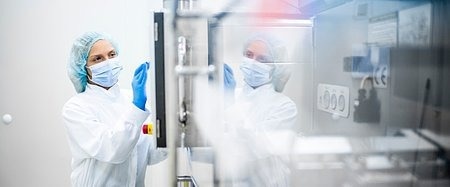Oxidative stress, caused by an imbalance of free radicals and antioxidants, regularly reduces the yield of pharmaceuticals and therapeutics produced via bioprocessing by about 10-15%. Now, Xheme, Inc.'s Xheme Multifunctional Additive (XMA), a programmable non-toxic nanoporous microparticle, has demonstrated the ability to significantly reduce or eliminate the damage of oxidative stress in bioprocessing conditions.

Image Credit: Xheme
The non-toxic additive, which also possesses antioxidant and antimicrobial properties, is a class of additive unto itself. XMA acts as a scavenger of reactive oxygen species (a free radical), which damage biomolecules, such as proteins, DNA, and lipids, during bioprocessing. XMA demonstrated superior performance as compared to currently used bioprocessing antioxidants in testing conducted by the Institute for Applied Life Sciences’ Cell Culture Core Facility at UMASS Amherst and O2M Technologies.
“We developed and executed methods that explored high and low levels of XMA powder under growth conditions similar to bioproduction,” said Michael P. Daley, Cell Culture Director at UMASS’ Institute for Applied Life Sciences which provided hands-on technical expertise in evaluating the effect of the additive.
“The XMA-incorporated polyethylene film showed the ability to significantly increase cell viability by about 15% compared to the control after 48 hours,” continued Mrignayani Kotecha, PhD, Founder and CEO of O2M Technologies, an oxygen imaging company located in Chicago.
Additionally, XMA demonstrated a dose dependent enhancement of cell proliferation of roughly 50%. The additive also has antibacterial activity, protects against gamma, x-ray, and UV radiation, and exhibits excellent biocompatibility with cells, leading to improved upstream bioprocessing results.
“These findings suggest that XMA-based cell culture media, bioprocessing bags, and trays will enable a significant increase in the yield and quality of the biologics produced,” concluded Daley.
“XMA is unlike any other additive being used in bioprocessing today,” explained Kumar Challa, Co-Founder, President, and Chief Scientific Officer of Xheme. “Unlike current anti-oxidants, which are either free-radical scavengers or remove peroxides, XMA is holistic—performing both functions. XMA is also regenerative, which other anti-oxidants are not, meaning less needs to be used for a better result.”
The increase in yield and quality could result in lower bioprocessing cost, which could then be passed on to consumers as savings.”
Kumar Challa, Co-Founder, President, and Chief Scientific Officer, Xheme
Advancing Drug Discovery and Cell Therapies
In addition to its impact on bioproduction, XMA holds great promise in accelerating drug discovery and reducing animal testing, aligning with the global trend of seeking alternatives to animal models. The use of 3-D organoids, grown from human and animal organ tissues, has gained traction in drug development due to their ability to replicate laboratory animal responses and simulate human body environments. However, unlike in animal models, oxidative stress and inadequate oxygenation of interior cells pose significant challenges to the widespread adoption of 3-D organoids.
XMA offers a potential solution to these obstacles. By adding XMA to tissue culture equipment or directly into the growth matrix, oxidative stress can be eliminated, and the interior cells can be adequately oxygenated.
“Using hydrogen peroxide to cause oxidative stress in a cellular model,” said Riccardo Amorati, PhD, an Associate Professor in the Department of Chemistry “G. Ciamician” at the University of Bologna who has worked with Xheme on previous studies “we showed that XMA-incorporated films converted damaging peroxides into oxygen and water.”
This breakthrough has the potential to revolutionize the soon-to-be $5.6 billion 3-D organoid industry and expedite the development of safer and more effective therapies.
Furthermore, he studies showed that XMA was not toxic to HEK293F in large doses (up to a 10,000µM concentration) and to human blood cells up to 100µM. Further testing is underway to determine if there is potential toxicity at greater concentrations.
Revolutionizing Bioprocessing
The XMA breakthrough technology could bring about significant changes in the industry, benefiting both manufacturers and healthcare consumers.
“XMA is a game-changing technology,” noted Paul von Kirchbach, an Xheme Advisory Board member and an international expert on sustainable polymers. “The impact of this discovery on the biotech industry will be revolutionary. Xheme is currently discussing with business partners and various biotech companies about testing XMA in bioprocessing products.”